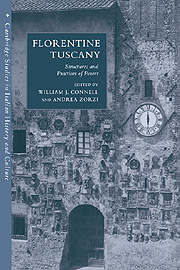Book contents
- Frontmatter
- Contents
- List of figures
- List of tables
- List of abbreviations of archival sources
- Introduction
- 1 The ‘material constitution’ of the Florentine dominion
- 2 The language of empire
- 3 Constitutional ambitions, legal realities and the Florentine state
- 4 Fiscality, politics and dominion in Florentine Tuscany at the end of the middle ages
- 5 Market structures
- 6 State-building, church reform and the politics of legitimacy in Florence, 1375–1460
- 7 The humanist citizen as provincial governor
- 8 Territorial offices and officeholders
- 9 Demography and the politics of fiscality
- 10 Florentines and the communities of the territorial state
- 11 Patronage and its role in government: the Florentine patriciate and Volterra
- 12 San Miniato al Tedesco: the evolution of the political class
- 13 The social classes of Colle Valdelsa and the formation of the dominion (fourteenth–sixteenth centuries)
- 14 Arezzo, the Medici and the Florentine regime
- 15 Rubrics and requests: statutory division and supra-communal clientage in Pistoia
- 16 A comment
- Index
- CAMBRIDGE STUDIES IN ITALIAN HISTORY AND CULTURE
3 - Constitutional ambitions, legal realities and the Florentine state
Published online by Cambridge University Press: 16 September 2009
- Frontmatter
- Contents
- List of figures
- List of tables
- List of abbreviations of archival sources
- Introduction
- 1 The ‘material constitution’ of the Florentine dominion
- 2 The language of empire
- 3 Constitutional ambitions, legal realities and the Florentine state
- 4 Fiscality, politics and dominion in Florentine Tuscany at the end of the middle ages
- 5 Market structures
- 6 State-building, church reform and the politics of legitimacy in Florence, 1375–1460
- 7 The humanist citizen as provincial governor
- 8 Territorial offices and officeholders
- 9 Demography and the politics of fiscality
- 10 Florentines and the communities of the territorial state
- 11 Patronage and its role in government: the Florentine patriciate and Volterra
- 12 San Miniato al Tedesco: the evolution of the political class
- 13 The social classes of Colle Valdelsa and the formation of the dominion (fourteenth–sixteenth centuries)
- 14 Arezzo, the Medici and the Florentine regime
- 15 Rubrics and requests: statutory division and supra-communal clientage in Pistoia
- 16 A comment
- Index
- CAMBRIDGE STUDIES IN ITALIAN HISTORY AND CULTURE
Summary
In 1409 Leonardo Bruni wrote in a letter to Niccolò Niccoli that a state was a society of people united in jurisdiction and living under the same laws (civitas autem est congregatio hominum iure sociatorum et eisdem legibus viventium). As Riccardo Fubini has pointed out, Bruni was articulating the pride which the Florentines must have felt at the beginning of the fifteenth century as they witnessed the spectacular expansion of their dominion over neighbouring cities; they believed they were participating in the foundation of a new territorial entity. Brum's notion that the acceptance of a single body of laws constituted an essential element of statehood was reflected in the new set of statutes compiled in 1415. In a conscious imitation of Justinian's example, the Florentines aimed to publish a coherent collection of laws that would be binding both on their own citizens and on their subject territories.
The Florentines had been preoccupied for some time with the mass of confused and contradictory legislation that had been issued over the years. The statutes of 1409, the work of Giovanni da Montegranaro, were an attempt to bring some order to this near chaos. The 1415 version, drawn up under the auspices of Paulus de Castro and Bartolomeo Volpi and better known thanks to its eighteenth-century edition, was revolutionary, both in terms of its organisation and in terms of its purpose, which was to provide a legal code for the new territorial state that had emerged.
- Type
- Chapter
- Information
- Florentine TuscanyStructures and Practices of Power, pp. 48 - 64Publisher: Cambridge University PressPrint publication year: 2000



